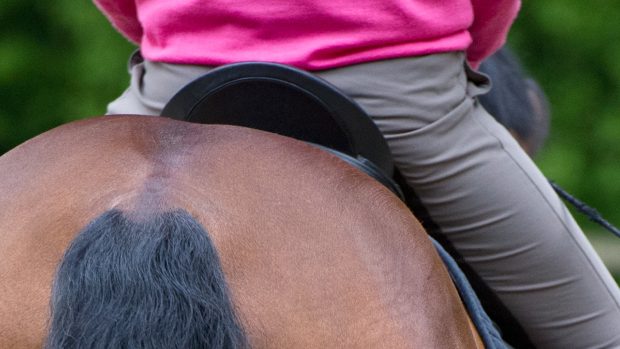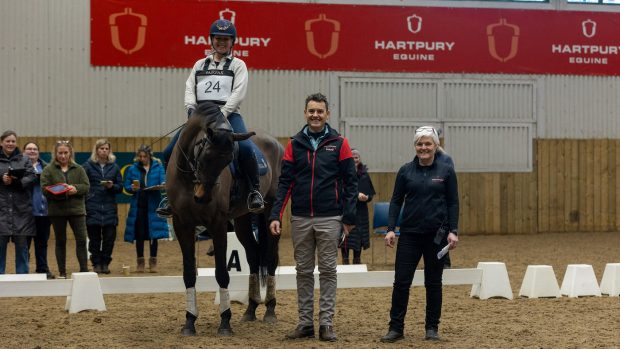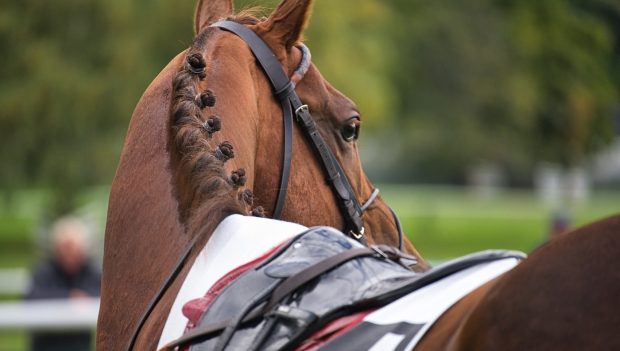We’ve got some great dissertation projects running at the moment here at Hartpury and, although it’s more my boss Kathryn’s department than mine, sharing an office with her does mean that I get to hear of what our students are up to.
Among this year’s studies is an investigation into the gait patterns of swimming horses and breathing rate in relation to this.
I’ve always had a bit of a fascination with how horses swim and hence was very excited to see some footage earlier this week as part of this project, which is being undertaken by one our part-time staff members and final year Hartpury student, Lizzy Drennan.
>>> Fizz Marshall’s therapy centre blog: Pre-season essentials and the ‘dead bug’
Ledbury-based racehorse trainer Ed de Giles granted access to his beautiful facilities to allow for Lizzy’s study, using a GoPro Hero 4 camera to get the video she needed. It took a bit of experimentation to get it right, involving positioning the camera on the end of a rather long pole, but the results are rather awesome as you can see from the video below.
It’s amazing to see the different ways horses approach swimming and we were of the impression before this study that they effectively trotted underwater, ie. moving in diagonal pairs, to propel themselves along.
It would seem however that their strokes can vary a lot more than this. We’ll know more when Lizzy finishes analysing her results, including what gait pattern makes the best and worst swimmers. What we do know is that horses position their hind legs wide of their normal position to generate the power required to swim, and such this is not dissimilar to how they move when galloping.
Horses that swim well tend to keep their backs closer to the surface level of the water, with those who don’t swim as effectively drop their hind quarters lower in the water, which in turn drags the back down.
In a couple of cases we’ve had horses sent in for water treadmill exercise as an alternative to swimming because they “swam like a stone” to quote the vet. The water treadmill doesn’t elicit the same response in heart rate as swimming however where you can push horses to near maximal levels and effectively maintain a decent level of fitness.
>>> Fizz Marshall’s therapy centre blog: in the Olympia spotlight
Where swimming can fall down is that it’s not necessarily suitable for horses with back pain as it the horse will normally put its head high and drop its spine into extension (downwards). As such, swimming can reinforce the posture of the back when it’s in pain, particularly in a horse that doesn’t swim well.
It’s easy to see why swimming is such a prevalent form of exercise in racing, where the need to keep the horse fit overrides the posture that is deemed more important in other sports. Leg injuries and the pressures of training on delicate thoroughbred feet can also be managed by swimming and thus is it a hugely valuable option for many trainers.
Managing behaviour
I got asked the other day if we have anyone working as part of our team who deals specifically with behavioural issues. My immediate response was that to be honest, we don’t really need it. Don’t get me wrong, most of the horses who come to us will have shown some expression of their injury or condition in their work aside from lameness, be that a refusal to go forward, bucking or refusing fences among many other things. In other cases, they may have been difficult to lead or handle at home during their early rehab when faced with no turnout and restricted exercise.
I absolutely believe that behavioural specialists are key professionals in the industry, and people like my fellow Horse & Hound blogger Jason Webb do a great job with all manner of horses, but for us any behaviour tags are normally related to either pain or an inability to do what is being asked. This is what makes the difference I think, because for the most part when you remove the pain stimulus by treatment and rehab, the behavioural issues will all but disappear also.
>>> Fizz Marshall’s therapy centre blog: A spine-tingling surprise
We will inevitably have hurdles to overcome but as long as we know what the problems were before, we can address these specifically and ground-schooling will take care of most issues. Working them from the ground is also a good way of getting a horse’s confidence up before getting back on board.
Horses that come in with a soft tissue injury, such as a tendon or ligament problem can actually be the trickiest horses to get back into ridden work as, although they may have trotted on the treadmill prior to being ridden, most of them are not allowed to be lunged.
I like to lunge a horses in its saddle before getting on board for the first time because if they are going to buck, they’ll normally get it out of their system at this point. If this is not an option we may well use some oral sedation issued by the vet, such as Sedalin or Domosedan to ensure the partnership remains intact.
Despite all of the above, I do have to sit tight every now and again, and for this reason I never ever ride without a neckstrap. I will admit to having mild palpitations if it’s forgotten!
I’m a bit superstitious and have one particular neckstrap that I trust; I’ve pulled very hard on it in various occasions in the past and it has never let me down! I think this obsession comes from the fact that my instinct is always to keep my hands forward and get out of the saddle if necessary, which in turn means the horse can be carrying on underneath me but I can absorb the movement better. I know other people who prefer a handle on the saddle which I can absolutely see the merits of, but it’s just not natural for me. And this is the key thing, if it all starts to go wrong, you don’t generally have time to think, you just react automatically.
I always want to ride forward when under duress, but in the quietest way possible as I think there are better ways to win an argument than laying into a horse, particularly if they are sharp — you are very likely to come off worse in this situation in my view.
Equally, manual reassurance is not always the best thing either as I was reminded earlier this week on a four-year-old that I have in at the moment having gone to pat him during an expression of his excitement to go out hacking. Patting lead to a full on explosion and frankly I should have known better — he is a racehorse and I think he thought I was changing my hands. Suffice to say I shall be keeping both hands firmly on the reins with him in future!
Fizz





